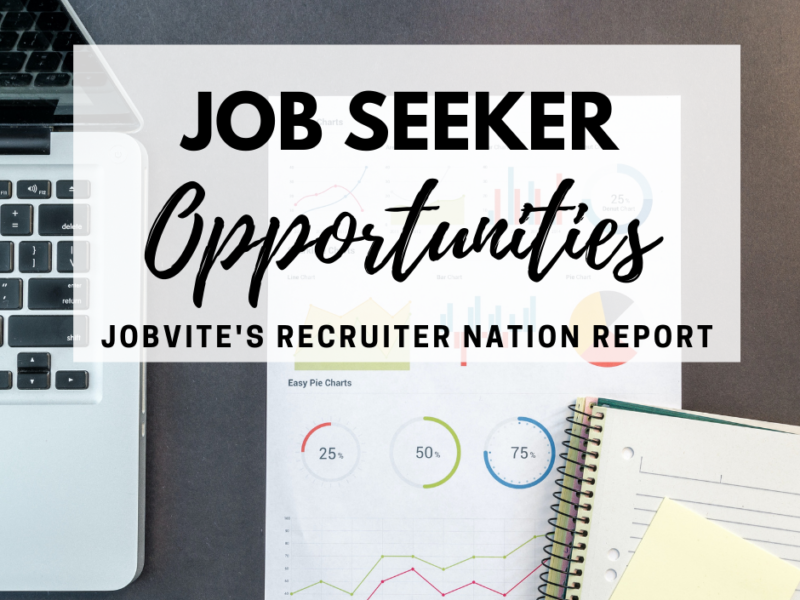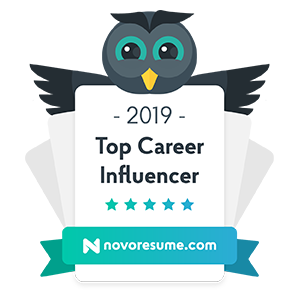Every year Jobvite surveys hundreds of recruiters and HR professionals for its annual Recruiter Nation Report to determine where the industry’s priorities lie and current hiring trends. The 2021 report is out and there’s plenty of information that you should know about. In this blog post I’ll share the most relevant survey results for job seekers. I’ll also explain what this means for you in terms of job seeker opportunities – especially where recruiters are concerned!
Recruiter strategy is an important part of any job search. Love ‘em or hate ‘em, you will likely need their help to get into your target company. (BTW I personally love them. I used to be one)! Regardless of where you fall on the recruiter spectrum, it’s a good idea to stay on top of the latest hiring and recruiting trends and adapt your strategy accordingly. If you are feeling a bit behind on recruiter networking, you’ll find this post on recruiters helpful.
About the Report
If you’ve ever wondered what’s inside a recruiter’s head in 2021, you’re not alone. Jobvite surveyed hundreds of recruiters and HR professionals to uncover this year’s trends. Unlike 2020 which was filled with a lot of job loss and reduced staffing, 2021 employment numbers are on the rise. Economic recovery has allowed for many companies to rapidly grow staffing levels. With this increase has come an increase in employee and candidate confidence levels. To respond to the talent growth, organizations are automating more processes in order to get talent quickly through the door. If you’re interested in getting the entire scoop on recruiting trends, you can check out Jobvite’s full report here.
If you just want the highlights in terms of how this impacts you, keep reading!
1. Resume accuracy and honesty are crucial for successfully working with recruiters
With people being ever-concerned with their chances of landing a job, it’s not surprising that some key pieces of resumes are prime targets for fabrication. According to the survey, 65% of recruiters have caught a candidate misrepresenting something on their resume including:
- 45% Technical Skills
- 44% Experience
- 37% Salary History
- 36% Education History
What this means for you
When it comes to your resume, cover letter, and LinkedIn profile it goes without saying: honesty is the best policy! This is especially true if you want to advance in the job process. If a recruiter finds out you are trying to pull a fast one, he will have no problem pulling you out of the candidate pool. And there’s nothing more embarrassing than a recruiter finding out from the hiring manager that his candidate lied! Bye-bye job prospect! So stay honest and transparent throughout the entire recruiting process. It will only serve you well in the end. If you want to know what else to avoid when working with recruiters, check out this blog post.
For the record, recruiters CAN check your technical skills, experience, salary history, and education history. And in the chance that they miss this, the hiring manager or someone in the hiring process may indeed pick up on the lie. So don’t risk it. Instead find a stronger way to brand yourself so that you are appearing to be the total package. Try using some of my 50 favorite resume keywords for greater brand impact. If your overall brand is strong, the little nuances in these particular items will not be as glaring.
Other resume areas where candidates misrepresent themselves
According to the survey, candidates are also likely to misrepresent within resumes when it comes to:
- 27% Citizenship Status
- 26% GPA
- 26% References
- 24% Competitive Offers
- 22% Tenure at previous jobs
- 21% Criminal History
- 20% Language Proficiency
What this means for you
Citizenship status is top of the list and this was also a common candidate cover-up in my recruiting days. So it’s worth addressing. If you are an international candidate and do not have the standard US work authorization you’ll want to disclose your work authorization status up front. Recruiters will not take kindly to someone who misrepresents this important detail. And you don’t want to end up wasting your time AND their time. Some of the most common statuses you will want to disclose up front include: OPT, H1B Visa, and/or any type of Student Visa. For 10 more of the most common resume eyesores, check out this blog post.
2. Top hiring sources for high-quality candidates
Recruiters use a number of different sources for finding candidates. According to the survey, these are the sources where recruiters find high quality candidates:
- 33% Job boards
- 30% Internal hires
- 30% Company’s career site
- 28% In-person recruiting events
- 27% Social Media
What this means for you
According to the study 33% of recruiters find high quality candidates on job boards. Here are some of my favorite job boards for job searchers hoping to get found. While this may sound like a great place to spend your time, be careful not to read too much into the numbers. Do not make job boards your only strategy while job searching. Why? Because only a small percentage of candidates online will be found and contacted by the recruiters. Recruiters are ONLY looking for the PERFECT fit for their job. If you are not a perfect fit, they won’t be contacting you and in turn you may waste a ton of time and effort on a fruitless activity. To achieve closer fit you need to mirror the job description using these techniques. While it’s important to be checking the job boards throughout your search, the most effective way to job search is networking and making personal connections. This is even more important if you are a career changer.
3. Social media channels most used for recruiting
Social media has become a regular hangout for most people nowadays. So it’s no surprise recruiters are frequenting social media channels in search of talent. Here are the channels recruiters use most for recruiting:
- 68% Facebook
- 65% LinkedIn
- 48% Twitter
- 46% Instagram
- 35% Youtube
What this means for you
LinkedIn has always been the obvious social media channel for professionals in the job search. However, it looks like Facebook is also a promising venue for professionals hoping to be found by recruiters. If you don’t have a Facebook account, you may want to think about joining for professional purposes. However, if you are content with LinkedIn as your platform of choice, it’s highly likely these same recruiters are checking LinkedIn as well. Here’s a great infographic that explains what recruiters and employers look for in social media profiles for Twitter, Facebook, and LinkedIn.
4. Social channels that source the highest quality candidates
Keep in mind that while recruiters have expanded their hunting grounds to include a variety of social media platforms (see above stats), there is still one platform that produces the HIGHEST quality candidates: LinkedIn.
- 53% LinkedIn
- 33% Facebook
- 22% Youtube
- 21% Twitter
- 20% Instagram
What this means for you
LinkedIn has long been known as the platform for professionals; not a personal showcase of your life outside work. Therefore, it’s not surprising that recruiters find the highest quality candidates on LinkedIn. Continue to optimize your presence and keep your LinkedIn brand up to date. Recruiters will always be looking on LinkedIn for those quality hires so that’s where you need to be! To become more searchable on LinkedIn try using this profile SEO strategy.
5. Biggest recruiter turn-offs when it comes to social media
Social media may feel like a place where you can let loose and share excerpts from your daily life, but it’s not as simple as that when it comes to recruiters. While you may be using social media to express yourself or relax, you may also be opening yourself up to major faux pas when it comes to how others form their first impressions of you. Recruiters were most turned off by this type of social media content, when searching for candidates:
- 45% Spelling and grammar errors in posts or tweets
- 40% References to marijuana
- 39% Alcohol consumption
- 30% Political posts
- 24% Pictures of body showing skin
“Viral social media challenges are popular but could hurt job prospects. Nearly 20% said participating in viral challenges or dances would negatively impact their decision to move forward with a candidate!”
What this means for you
The insights from these stats should be obvious but I see enough inappropriate social media posting that it would seem they are anything but obvious to the average user!
- Number one, if you can’t spell in your social media presence, you probably don’t have the attention to detail needed by most employers. Take the time to get the spelling right when posting. When it comes to resume writing, this is the spelling and grammar tool that I swear by! Fully worth installing the free version on your laptop!
- Yes marijuana is becoming more widely available and accepted. However, that doesn’t mean it is accepted by everyone. If someone who doesn’t share your zeal for cannabis, comes across your marijuana posts, good luck getting called for the job.
- Same goes for alcohol consumption. No one wants to deal with a hungover employee calling in sick or abusing alcohol on the job!
- Political posts – this should again be obvious but given the amount of political posts I see on a regular basis online, it’s clear that it is no longer obvious. You may be very passionate about your politics, but just remember: the recruiter or hiring manager may be on the opposite end of the political spectrum. This won’t create the strongest first impression and you may be passed up for someone who is less politically vocal. You’re welcome to your own views and political leanings, but the key is in keeping it to yourself (at least until after you’re hired).
- Last but not least, no one wants to see your sexy selfies. Put on some clothes and keep it professional!
6. What matters and what doesn’t to recruiters
According to the survey, these were the factors rising in importance from 2017 – 2021:
- Online education or certificates: 8% up to 39%
- Resume format 17% up to 36%
- Cover letter: 8% up to 26%
- Online social presence: 14% up to 25%
What this means for you
With online education or certificates rates jumping, this means that career changers and pivoters can now gain a bit more traction. Online education/certificates are great branding pieces for making a career change – and it says something that recruiters are paying more attention to this. That online course you once wondered about, may be worth your while to take. Wondering if you should get that MBA you always wanted? Here’s my take on that for your reference. Add it to your resume and consider it a valuable keyword and experiential enhancement!
Recruiters are also honing in on resume format more than they used to. This means you can no longer use that old resume formatting you’ve been clinging to! It’s time for a resume upgrade. Here are the most common types of resume formats including the format recruiters love most!
Cover letters have also increased in importance for recruiters. Cover letters are typically not very important to recruiters in demonstrating the candidate’s abilities. However, it could be the case that cover letters are critical in helping the strong candidates stand out. A cover letter will certainly provide an edge against candidates who haven’t taken the time to make the effort. Haven’t written a cover letter in a while? Follow this simple cover letter writing guide with templates included!
7. Factors declining in importance when evaluating candidates (2017 – 2021)
- Previous job experience: 92% down to 62%
- Employer referral: 51% down to 31%
- Cultural fit: 83% down to 28%
What this means for you
Previous job importance is supposedly declining in importance during the candidate evaluation process. This comes as a surprise since previous experience is all recruiters have to go on to determine future potential. However if this refers to experience greater than 10 years ago, then this would seem to be correct. Much older experience is rarely considered as important as current experience. As a rule, if you have more than 10-15 years of experience, you’ll want to omit that from your resume.
Employer referrals as a key success factor for candidates has also declined. In my experience, referrals are never weighted as heavily as actual candidate qualifications, in the hiring process. Therefore you don’t want to worry too much about your referrals. They won’t make or break your chances of advancing in the hiring process (and are usually only viewed at the very end of the process).
8. Workers have the upper hand in salary negotiation
73% surveyed recruiters report at least a moderate increase in negotiating for higher salaries among candidates and current employees – up more than 20% since 2020. Salaries have also significantly increased with 56% reporting average salaries across their industry have increased 2021. 48% report an average salary increase of more than 10%.
What this means for you
If salaries are increasing and more people are negotiating, it’s in your best interest to negotiate. Employers expect it and will be more open to having the negotiation conversation given this data. If you do plan to negotiate (and you should), beware of these common salary negotiation mistakes.
9. Referrals and internal mobility
Referral programs are on the rise with 79% of organizations offering employee referral programs – an 8% increase over the past year. 48% are seeing higher participation in employee referral programs in 2021. Internal hires remain vital to hiring success with 40% are making more hires from internal employees since the onset of the pandemic.
What this means for you
If referral programs are on the rise, that means huge opportunities for job seekers! The best way to benefit from an employee referral program is by networking with the employees! Networking has long been our job search tactic of choice but this data suggests that your chances of getting referred into the company are now greater than before. Therefore it’s time to put the LinkedIn networking in overdrive. Generate as many informational interviews as you can at your target companies. You never know when one of those will be the referral you’re hoping for! If you’re feeling a bit rusty when it comes to informational interviewing, check out my explainer blog post here.
10. Side hustles on the rise
As you may have noticed in the market, side hustles and gig work is on the rise. 54% of recruiters are seeing more employees taking on side jobs. 35% of organizations are outsourcing more jobs to freelancers and gig workers – a 13% upward shift since 2021. 54% of organizations plan to outsource even more jobs going forward!
What this means for you
Don’t overlook the side hustle or freelance jobs at your target company. Some companies like to hire freelance first in order to test the candidate – to try before they buy. That said, the best way to prove yourself and get into your dream company is by pursuing these types of temporary work opportunities.



 How to Rebuild Career Confidence to Re-enter the Workforce
How to Rebuild Career Confidence to Re-enter the Workforce


